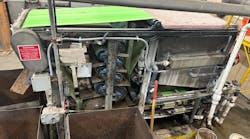With Hurricane Katrina approaching, Veolia Water employees at New Orleans’ East Bank Wastewater Treatment Plant spent several days in late August 2005 implementing the company’s hurricane preparedness program. Although the full magnitude of that hurricane could not have been predicted, the employees’ advance work turned out to be time well spent.
During a severe crisis, anticipation and preparation are crucial. It cannot be understated that a crisis plan must imagine and prepare for the worst possible scenarios, as crises of Katrina magnitude can take unprepared facility managers by surprise. Greater advanced planning means a quicker and more effective response.
This article outlines one facility’s response to Hurricane Katrina, and along with offering useful tips, is meant to provide strategies for managers looking to prepare for extreme crises.
Preparation
From the outset of the crisis, Veolia Water established a clear goal: Keep the 122-million-gal-per-day facility operating for as long as possible. This would provide essential services to the public and environmental protection for the Mississippi River and Gulf Coast region, while keeping the massive storm water pumps operational during the storm to protect the assets of the New Orleans Sewerage and Water Board (NOS-WB). Knowing that most employees would need to be evacuated shortly before landfall, an emergency team of four was identified beforehand and prepared to ride out the storm in a fourth-floor control room at the plant.
A similar issue was faced at another facility 20 miles away in Kenner, where high floodwaters made departure impossible. Fortunately, the team had finished implementing a hurricane preparedness program the day before. Team members eventually made it to Kenner City Hall, where they played key roles in manning the city’s 24-hour call center to support the mayor and his crisis response team.
Immediate Action Items
The first order of business in New Orleans was, and in any crisis is, to rescue employees who are stranded and to verify that those in impacted areas are safe and their basic needs are being met. During Hurricane Katrina, this became particularly challenging because communications systems were down or severely overloaded for weeks after the storms.
Attention was focused on ensuring the safety of the client’s valuable assets and to ensuring environmental protection. A task force of employees from other projects in nonaffected areas was assembled to help aid the efforts of the crew on the ground. The skills of these employees included expertise in human resources, environmental health and safety, engineering and construction. By leveraging their experience, Veolia was able to effectively assess the condition of client facilities, workforce and equipment and help triage recovery efforts. This additional team support also helped procure equipment, including pumps, generators, hoses and piping necessary for cleanup, and began to execute a plan to dewater the site.
Support from colleagues companywide arrived in the form of cash donations, clothing, personal items and gift cards. In a crisis, employees in nonimpacted areas may wish to help, and if it is possible, putting a fundraising structure in place can direct much-needed financial support to affected areas and provide additional relief to on-the-ground work. Collectively, Veolia Water North America and its North American-based sister companies were able to donate $1 million to charities.
Secondary Action Items
Within a month, the East Bank facility had been completely dewatered; this required air lifts and trips by boat to move personnel, pumps and other heavy equipment. Two weeks later, 30 million gal of wastewater was pumping through the plant each day. The task force now turned its attention to establishing specific priorities and a detailed plan of action to meet a strict U.S. Environmental Protection Agency (EPA) goal for recovery.
Teams set to work repairing essential pieces of equipment and plant processes to establish primary treatment, including the removal of trash, rags, debris, sand, grit and then the settling of suspended and dissolved wastewater solids. The next step involved disinfection and pumping of the wastewater to the Mississippi River. After this, the focus turned to those essential equipment items and plant processes associated with secondary (biological) treatment. This included rehabilitation of the oxygen reactor, pure oxygen system, re-establishment of the microbial population, final clarifier repair and rehabilitation of the sludge disposal system.
Throughout the process, Veolia maintained strong communication with the NOS-WB, city of New Orleans, EPA, Louisiana Department of Environmental Quality, Federal Emergency Management Agency and other stakeholders. This was crucial to bringing the plant back online quickly and helped secure funding for critical projects. Having an onsite client officer from the NOS-WB helped with approval of projects and providing an authorized signature for the expenditure of funds to rehabilitate the plant.
Recovery
Although some industry experts predicted it might take one year or more to bring the treatment plant back online, the EPA gave the city of New Orleans and Veolia Water North America a deadline of 60 days to restore both primary and secondary wastewater treatment. Note that if infrastructure is considered critical to the welfare of the city, the timetable for recovery may be accelerated.
To further complicate issues, it is likely that many employees will be dealing with their own personal losses in a crisis. Nearly 40 New Orleans employees lost their homes in the flooding. While receiving assistance from the company and fellow employees, their willingness to sacrifice for the common good of the city enabled primary and secondary wastewater treatment to be restored at the East Bank plant by November 2005. The EPA deadline was met and an analysis of best practices was conducted after the fact to aid in preparation and recovery for future crises.
Today, the East Bank plant bears few signs of damage left behind by the Katrina flooding. After millions of dollars of improvements, the plant is operating at peak efficiency. Veolia and its partners are bonded through their shared experience of the disaster and have a renewed commitment to delivering service and technological excellence to the communities served. The work is a testament to the shared sacrifice of the employees at that facility, which inspired the entire organization.
SIDEBAR:10 Tips for Handling a Crisis
- Preparation for a worst-case scenario is critical. A written plan of action should be in place before a disaster strikes.
- Think safety first and take care of employees—provide for their needs and reward their efforts. Identify a safe location for emergency operations.
- Set a goal and develop an action plan and timeline for bringing systems back online.
- Understand that in a true crisis, staff may have to be evacuated. If your work is essential to a city’s recovery, identify and plan for reduced staff as far in advance as possible.
- If your facility is deemed critical by the EPA or local government, be aware that bringing operations back to normal likely will need to occur on a fast timetable.
- During a crisis, employees likely will be dealing with personal crises on top of their critical roles in managing city infrastructure. Be prepared for extreme working conditions.
- Employees in nonimpacted areas may express a strong desire to help. If you have the ability, organizing a fundraising drive can help direct money to afflicted regions in addition to your own on-the-ground response work.
- Because crisis-mandated evacuations can quickly reduce the size of an on-the-ground response crew, if possible, plan in advance to leverage resources in non-afflicted areas to help with essential tasks. This frees available, on-the-ground employees for high-priority duties.
- After the disaster, utilize resources and networks to assemble the right team to respond.
- In a crisis, communications often are disrupted. Work quickly to re-establish communications, as this likely will be critical to recovery. Company websites can be used to communicate with the general public as well as with employees.
Download: Here

